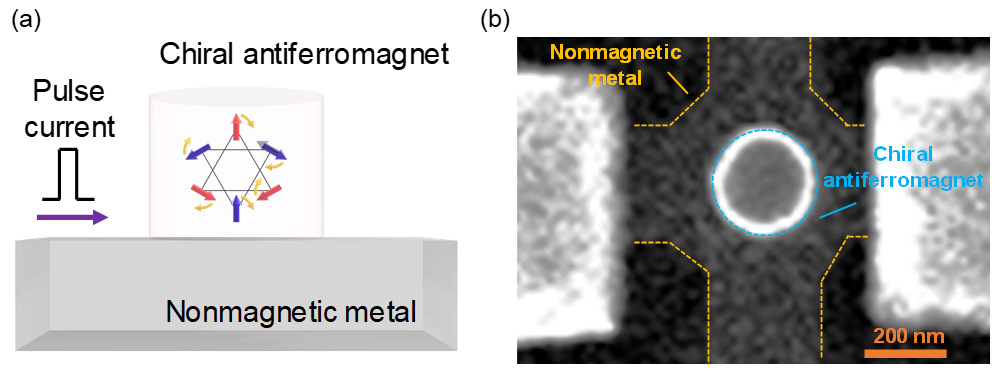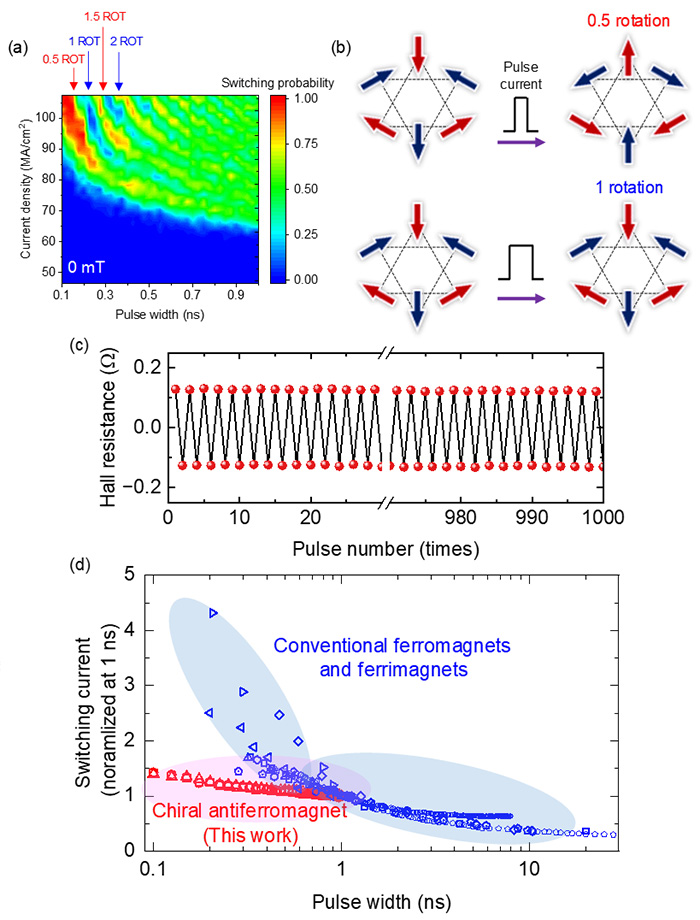

Advances in spintronics have led to the practical use of magnetoresistive random-access memory (MRAM), a non-volatile memory technology that supports energy-efficient semiconductor integrated circuits. Recently, antiferromagnets—magnetic materials with no net magnetization—have attracted growing attention as promising complements to conventional ferromagnets. While their properties have been extensively studied, clear demonstrations of their technological advantages have remained elusive.
Now, researchers from Tohoku University, the National Institute for Materials Science (NIMS), and the Japan Atomic Energy Agency (JAEA) have provided the first compelling evidence of the unique benefits of antiferromagnets. Their study shows that antiferromagnets enable high-speed, high-efficiency memory operations in the gigahertz range, outperforming their ferromagnetic counterparts. The findings were published in the journal Science on August 21, 2025.

(a) Schematic illustration of memory device consisting of chiral antiferromagnet Mn3Sn / nonmagnetic metal heterostructure (b) A scanning electron microscope image of the fabricated device with Mn3Sn nanodot and nonmagnetic metal channel. ©Yutaro Takeuchi et al.
The team used the chiral antiferromagnet Mn3Sn, whose spins form a non-collinear arrangement, as the medium for writing digital information. They fabricated a nanoscale Mn3Sn dot device and successfully induced coherent rotation of its antiferromagnetic texture using electric currents. This enabled fast, high-fidelity control of spin ordering.
The system achieved efficient switching with 0.1-nanosecond current pulses—faster than any ferromagnetic device—while requiring no external magnetic field. Remarkably, the device demonstrated 1,000 error-free switching cycles, a level of reliability not possible in ferromagnets.
“Achieving 1,000 switchings out of 1,000 trials with a 0.1-nanosecond current pulse at zero magnetic field has been unreachable for ferromagnets—but turns out not to be the case for antiferromagnets,” said Yutaro Takeuchi, the paper’s lead author.

(a) Switching probability versus current density and pulse width. (b) Illustration of switching (switching-back) dynamics through coherent spin rotation of chiral antiferromagnet (c) Demonstration of the 1,000/1,000 switching. (d) Pulse width dependence of normalized switching current in chiral antiferromagnet, conventional ferromagnets and ferrimagnets. ©Yutaro Takeuchi et al.
“This antiferromagnetic advantage stems from a qualitative difference in their switching dynamics,” explained Yuta Yamane, who led the theoretical modeling. “In conventional ferromagnets, magnetization undergoes three-dimensional precessional motion. In contrast, antiferromagnetic switching is completed through two-dimensional rotation of the chiral spin structure with an effective inertial mass—a key factor not seen in ferromagnets.”
Shunsuke Fukami, the project supervisor, emphasized the breakthrough: “Researchers had shown in recent years that antiferromagnets can do what ferromagnets can do. Our work, for the first time, shows that antiferromagnets can do what ferromagnets cannot do.”
These results mark a significant step toward next-generation semiconductor device technology powered by antiferromagnets. By unlocking ultrafast and energy-efficient switching without external fields, the research opens up new pathways for spintronics-based memory and logic devices, advancing the pursuit of high-performance, low-power electronics.
| Title: | Electrical coherent driving of chiral antiferromagnet |
|---|---|
| Authors: | Yutaro Takeuchi, Yuma Sato, Yuta Yamane, Ju-Young Yoon, Yukinori Kanno, Tomohiro Uchimura, K. Vihanga De Zoysa, Jiahao Han, Shun Kanai, Jun’ichi Ieda, Hideo Ohno, and Shunsuke Fukami |
| Journal: | Science |
| DOI: | 10.1126/science.ado1611 |
Shunsuke Fukami (Profile of Prof. Fukami)
Research Institute of Electrical Communication
| E-mail: | s-fukami@tohoku.ac.jp |
|---|---|
| Webstie: | Fukami Laboratory |